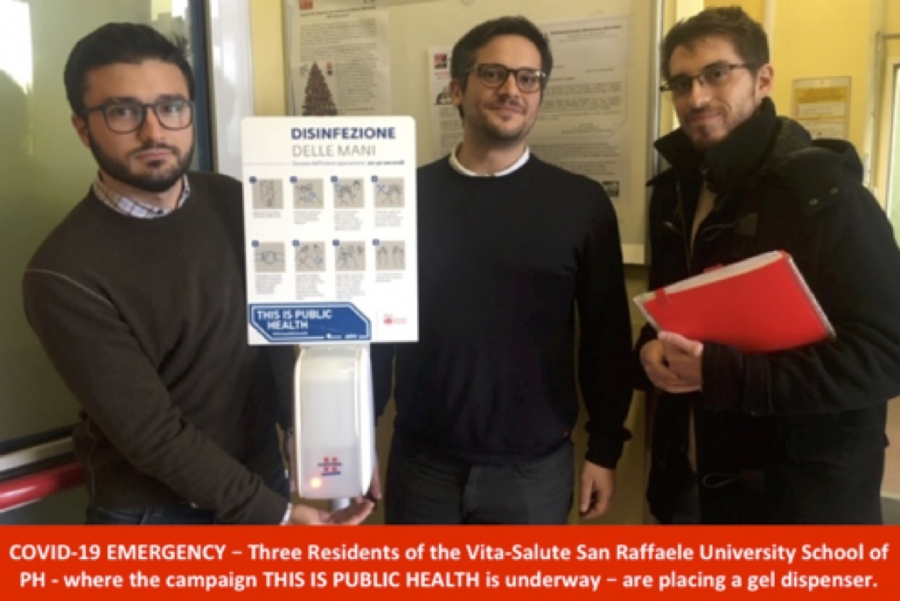The World Health Organization on March 10th, 2020, declared the COVID-19 as “pandemic”. In just 2 months, the whole globe has changed its priorities to face this problem. At this moment Italy is currently holding the highest burden in Europe, with an incidence of infections of ≈25x100000 and with 15,000 registered cases (as of 12th March) but also other European countries are reporing increasing cases (Norway 12,9, Denmark and Switzerland 10, Spain 6.3, France 3.4 and Germany 2.5 as of 12th March).
In Italy, there are around 800 public health residents, enrolled in 35 Public Health Schools (Igiene e Medicina Preventiva) all over the country. Almost all Italian public health residents are engaged in activities that directly or indirectly concern this emergency. Their activities are linked to the profile and tasks of the various schools.
 Emergency tasks are well included in the curricular activities of a resident and provide a unique and instrumental experience during the training of the Public Health Experts of tomorrow. Residents’ activities during the COVID-19 emergency include the production, evaluation, interpretation and implementation of guidelines and laws provided by international, national and local authorities in the community and hospital setting. Residents also supervise the reallocation and creation of beds available in specific wards like intensive care units and internal medicine-COVID-19-specific units, with the aim of providing continuous quality care to COVID-19 patients. Moreover, they participate in the tasks involving emergency room reorganization, pre-triage deployment and the definition of specific pathways for COVID-19 suspected/confirmed patients in order to warrant their utter separation from other patients and to limit the spreading of SARS-CoV-2. In addition to that, they are involved in the processes regarding the redeployment of ordinary activities, such as clinics and relative resources to different facilities to help patients’ management. On a final note, they provide support in safeguarding every employee/patient/passerby in the hospital setting from any possible hazard linked to SARS-CoV-2 while monitoring the constant supply-chain and stockpile of appropriate PPEs masks during the emergency in the hospital setting.
Emergency tasks are well included in the curricular activities of a resident and provide a unique and instrumental experience during the training of the Public Health Experts of tomorrow. Residents’ activities during the COVID-19 emergency include the production, evaluation, interpretation and implementation of guidelines and laws provided by international, national and local authorities in the community and hospital setting. Residents also supervise the reallocation and creation of beds available in specific wards like intensive care units and internal medicine-COVID-19-specific units, with the aim of providing continuous quality care to COVID-19 patients. Moreover, they participate in the tasks involving emergency room reorganization, pre-triage deployment and the definition of specific pathways for COVID-19 suspected/confirmed patients in order to warrant their utter separation from other patients and to limit the spreading of SARS-CoV-2. In addition to that, they are involved in the processes regarding the redeployment of ordinary activities, such as clinics and relative resources to different facilities to help patients’ management. On a final note, they provide support in safeguarding every employee/patient/passerby in the hospital setting from any possible hazard linked to SARS-CoV-2 while monitoring the constant supply-chain and stockpile of appropriate PPEs masks during the emergency in the hospital setting.
Public Health Residents have also an important role in the local Public Health Services; in particular in some Italian Regions the activity of contact-tracing is going on and it is very active. Furthermore, they collaborate with Health Ministry Agencies on the territory in the epidemiological tasks focused on data collection, modeling and health surveillance. Since there are 3,724 people in home isolation (update 11.03.2020 at 6 pm), residents are involved in evaluating health status and coordinate to solve any needs that these people may have.
The European Emergency phone number 112 in Italy has increased its activity, thus Public Health Residents can participate in coordinating jobs that range from telephonic triage of patients, to ambulance and inter-hospital Emergency Room management.
This COVID-19 pandemics can be seen both as a moment in which every health care professional must help the population, both as an important chance for Public Health residents to learn particular and unique skills and give their supports to overcome this worldwide emergency.
(Board of Italian Public Health Schools and Residents)





